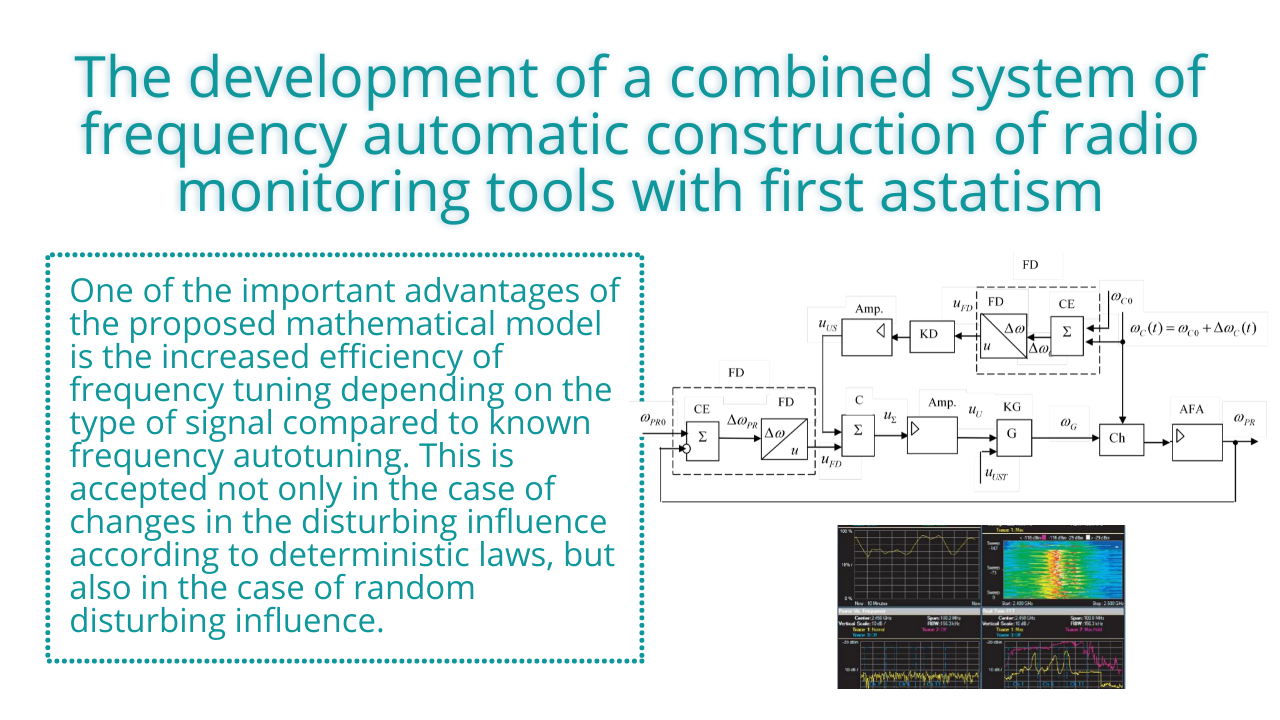The development of a combined system of frequency automatic construction of radio monitoring tools with first astatism
DOI:
https://doi.org/10.15587/2706-5448.2024.310043Keywords:
automatic autotuning systems, static frequency autotuning systems, first-order astatismAbstract
At the present time, phase auto-adjustment systems are widely used, in which frequency stabilization and frequency tracking is achieved due to phasing of the reference (setting) and control voltages. Frequency auto-adjustment systems solve this problem as a result of direct measurement of the difference in frequencies of the reference and control voltages, and reduction of this difference. The scientific task solved in the research is to increase the dynamic characteristics of automatic tuning systems, to increase the dynamic accuracy and speed of frequency auto-tuning systems of radio monitoring devices with astatism. Therefore, the object of research is the system of automatic self-adjustment of military radio monitoring equipment. The subject of the research is the dynamic, root mean square errors of automatic self-tuning systems under different laws of change of the disturbing influence (input signal frequency deviation) and the speed of the systems. The methods of analysis and synthesis, the theory of complex technical systems and the theory of radio receiving devices were chosen as the basic mathematical apparatus in the proposed research. The research proposed a combined system of frequency auto-adjustment of radio monitoring devices with astatism, as well as basic mathematical expressions that describe its operation. In the process of research the following tasks were solved:
– an analysis of the dynamic characteristics of a static system of frequency auto-adjustment with the principle of deviation control was performed;
– a functional scheme and a mathematical model of a combined frequency auto-adjustment system with first-order astatism and increased speed were developed.
One of the important advantages of the proposed mathematical model is the increased efficiency of frequency tuning depending on the type of signal compared to known frequency autotuning. This is accepted not only in the case of changes in the disturbing influence according to deterministic laws, but also in the case of random disturbing influence.
The direction of further research should be considered the increase in dynamic accuracy (reduction of dynamic, root mean square errors) and speed of frequency auto-adjustment systems.
References
- Yahya, A., Sidek, O., Mohamad-Saleh, J. (2008). Performance analyses of fast frequency hopping spread spectrum and jamming systems. The International Arab Journal of Information Technology, 5, 115–119.
- Perez-Solano, J. J., Felici-Castell, S., Rodriguez-Hernandez, M. A. (2008). Narrowband Interference Suppression in Frequency-Hopping Spread Spectrum Using Undecimated Wavelet Packet Transform. IEEE Transactions on Vehicular Technology, 57 (3), 1620–1629. https://doi.org/10.1109/tvt.2007.909306
- Lavaud, C., Gerzaguet, R., Gautier, M., Berder, O., Nogues, E., Molton, S. (2020). Towards Real Time Interception of Frequency Hopping Signals. 2020 IEEE Workshop on Signal Processing Systems (SiPS). https://doi.org/10.1109/sips50750.2020.9195246
- Sârbu, A., Șorecău, M., Șorecău, E., Bechet, P. (2023). Frequency hopping signals tracking and sorting algorithm for military radio networks. 2023 International Symposium on Electromagnetic Compatibility – EMC Europe. https://doi.org/10.1109/emceurope57790.2023.10274264
- Artemev, V. M. (1984). Spravochnoe posobie po metodam issledovaniia radioelektronnykh slediashchikh sistem. Vyshei, shk., 168.
- Hokov, O. M. (2022). Fizychni osnovy tekhnichnykh zasobiv rozvidky. Kharkiv: KhNEU im. S. Kuznetsia, 255.
- Zaitcev, G. F. (1989). Teoriia avtomaticheskogo upravleniia i regulirovaniia. Kyiv: Vishcha shk., Golovnoe izd-vo, 431.
- Zaitcev, G. F., Steklov, V. K. (1978). Kombinirovannye slediashchie sistemy. Kyiv: Tekhnika, 264.
- Smirnov, Yu. O. (2009). Osnovy radioelektronnoi rozvidky. Chastyna 1. Rozviduvalno-informatsiinyi protses, osnovni modeli systemy RER efektyvnist i napriamy yii podalshoho rozvytku. Kyiv: NDI HUR MO Ukrainy, 155.
- Levchenko, O. V., Fedotov, B. M. (2006). Systemy i kompleksy radioelektronnoi rozvidky. Kyiv: NAOU.
- Pampukha, I. V., Buryi, S. V., Pusan, V. V. (2017). Analiz suchasnykh avtomatychnykh system monitorynhu radio prostoru na bazi SDR tekhnolohii dlia vedennia zavdan radioelektronnoi rozvidky. Zbirnyk naukovykh prats Viiskovoho instytutu Kyivskoho natsionalnoho universytetu imeni Tarasa Shevchenka, 56, 40–46.
- Okhramovych, M. M., Shevchenko, V. V., Kravchenko, O. I. (2018). Analiz sposobiv vedennia monitorynhu radioprostoru za dopomoho SDR tekhnolohii. Zbirnyk naukovykh prats Viiskovoho instytutu Kyivskoho natsionalnoho universytetu imeni Tarasa Shevchenka, 59, 37–45.
- Rembovskii, A. M., Ashikhmin, A. V., Kozmin, V. A.; Rembovskii, A. M. (Ed.) (2010). Radiomonitoring – zadachi, metody, sredstva. Goriachaia lin. – Telekom, 624.
- Slobodianiuk, P. V., Blahodarnyi, V. H., Stupak, V. S.; Slobodianiuk, P. V. (Ed.) (2008). Dovidnyk z radiomonitorynhu. Nizhyn: Aspekt – Polihraf, 588.
- Stupak, V. S., Dolmatov, S. O.; Oliinyk, V. F. (Ed.) (2004). Osnovy radiochastotnoho kontroliu. Kyiv: Feniks, 231.
- Slobodianiuk, P. V., Narytnyk, T. M., Blahodatnyi, V. H., Saiko, V. H., Bulhach, V. L.; Kryvuts, V. H. (Ed.) (2012). Teoriia i praktyka upravlinnia vykorystanniam radiochastotnoho resursu. Kyiv: DUIKT, 586.

Downloads
Published
How to Cite
Issue
Section
License
Copyright (c) 2024 Serhiy Hatsenko, Ivan Vasylyaiko, Dmytro Burlak

This work is licensed under a Creative Commons Attribution 4.0 International License.
The consolidation and conditions for the transfer of copyright (identification of authorship) is carried out in the License Agreement. In particular, the authors reserve the right to the authorship of their manuscript and transfer the first publication of this work to the journal under the terms of the Creative Commons CC BY license. At the same time, they have the right to conclude on their own additional agreements concerning the non-exclusive distribution of the work in the form in which it was published by this journal, but provided that the link to the first publication of the article in this journal is preserved.







